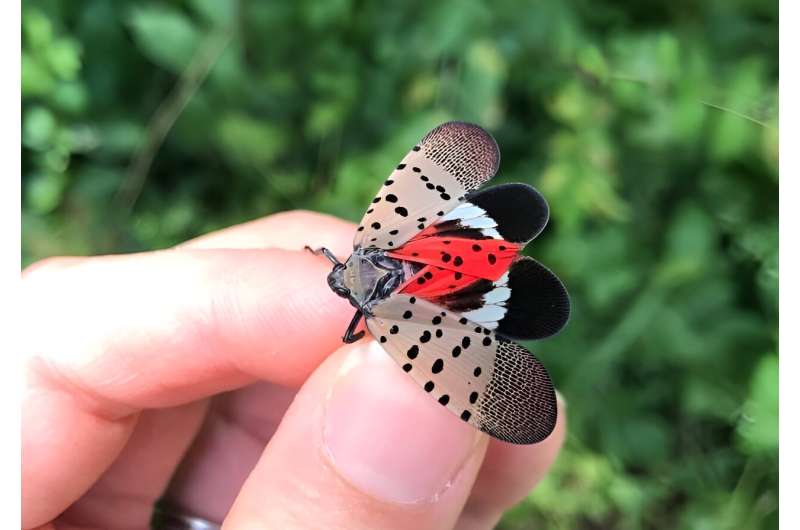This article has been reviewed according to Science X's editorial process and policies. Editors have highlighted the following attributes while ensuring the content's credibility:
fact-checked
trusted source
proofread
Now entering their adult phase, spotted lanternflies are headed into their invasive peak

As you head out on summer adventures this month, make sure that an unwanted guest isn't traveling with you.
The adult spotted lanternfly begins to appear in mid-July. During this destructive phase, it grows its namesake spotted wings, enabling it to conquer new geographic distances of up to 5 miles on its own.
With the assistance of humans, it can hitch rides on vehicles and spread hundreds of miles to previously uninfested locations.
"The spotted lanternfly is an unfortunate lesson in being careful about what you move," said Virginia Tech entomologist Eric Day. "Adult spotted lanternflies are very good hitchhikers. Make sure whatever you're moving, it's pest-free."
As July brings the start of the spotted lanternfly's most destructive phase, Day and Virginia Cooperative Extension experts have a few tips and reminders for the public to help control the spread.
What does a spotted lanternfly look like in its adult stage?
Adult spotted lanternflies are about an inch long and a half-inch wide. They have gray forewings with black spots and bright red lower hindwings with black spots and a white stripe.
Where are spotted lanternflies?
Spotted lanternflies have been confirmed in 17 states. They are concentrated mainly on the East Coast but have also been reported as far west as Iowa.
In Virginia, they are present in 48 cities and counties. Twelve counties and 10 cities are under quarantine, which means vehicles moving goods across city and county lines must be inspected by the Virginia Department of Agriculture and Consumer Services for the lanternfly and its eggs.
Which plants do spotted lanternflies harm?
Spotted lanternflies enjoy feeding on more than 70 species of trees and herbaceous plants. They are a significant threat to grapes, vineyards, and a wide range of fruit trees. The pest's favorite host is another invasive species called the tree of heaven.
Why are spotted lanternflies problematic?
Spotted lanternflies are a threat to the agriculture, forestry, logging, trucking, and construction industries due to their capacity to damage trees and crops and hitch rides on machinery and equipment. They are also a nuisance to homeowners.
In their adult phase, spotted lanternflies feed in large groups and produce a sticky, sweet waste product called honeydew. Honeydew builds up on the ground, surrounding vegetation, and other surfaces like houses and patios—which leads to the development of a plant-harming fungal disease called sooty mold. Honeydew also produces an intense, rotten smell and attracts additional pests.
How do I get rid of spotted lanternflies?
Kill them on sight, by stomping or squashing them. Check cars, trailers, and equipment for spotted lanternflies before moving them to another location.
If you have the tree of heaven on your property, remove it.
For tips on the use of effective chemical and biological controls, visit Virginia Cooperative Extension's Best Management Practices for Spotted Lanternfly in Yards and Landscapes and Homeowner Suggestions for Managing Spotted Lanternfly, or reach out to your local Extension office. An extensive library of online resources on the spotted lanternfly is available here.
Provided by Virginia Tech



















